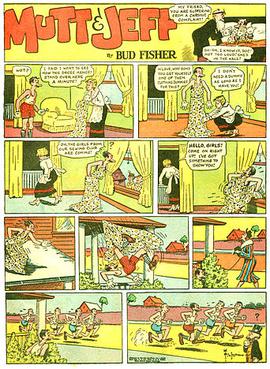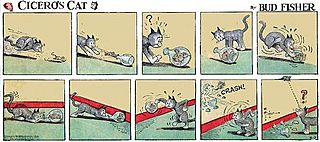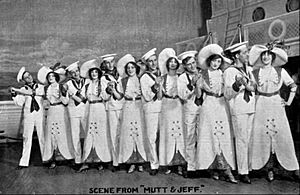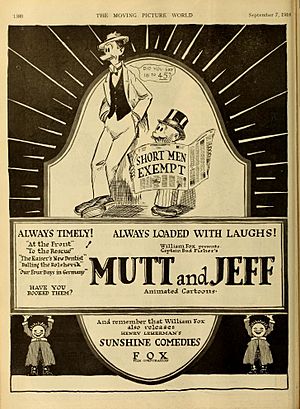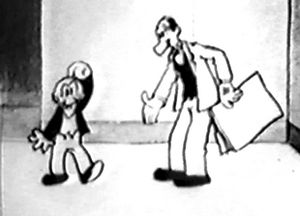Mutt and Jeff facts for kids
Quick facts for kids Mutt and Jeff |
|
|---|---|
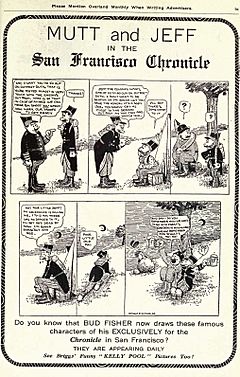
Overland Monthly ad (January 1916)
|
|
| Author(s) | Bud Fisher (1907–1932) Al Smith (1932–1980) George Breisacher (1980–1983) |
| Current status/schedule | concluded; reruns |
| Launch date | November 15, 1907 |
| End date | June 26, 1983 |
| Alternate name(s) | A. Mutt |
| Syndicate(s) | King Features Syndicate (1907–1915) Wheeler Syndicate / Bell Syndicate (1915–c. 1944) Field Newspaper Syndicate (1944–1983) Andrews McMeel Syndication (reruns) |
| Genre(s) | humor |
Mutt and Jeff was a very popular American newspaper comic strip. It was created by cartoonist Bud Fisher in 1907. The comic was about "two mismatched friends" and is often seen as the first daily comic strip. Before Mutt and Jeff, there was a short-lived strip called A. Piker Clerk by Clare Briggs. However, Mutt and Jeff was the first successful daily comic strip. It showed how future comic strips would be made.
Mutt and Jeff was published until 1983. Many cartoonists worked on it, especially Al Smith, who drew the strip for almost 50 years. The series also became comic books, cartoons, films, and other fun merchandise.
Contents
The Comic Strip's Big Success
Harry Conway "Bud" Fisher was a sports cartoonist for a newspaper called the San Francisco Chronicle. Back then, most newspaper cartoons were just one picture. Bud Fisher had a new idea: he wanted to tell a funny story using a series of pictures, or a "strip." This made his comic strip the first successful one to use this popular format.
His comic strip, first called A. Mutt, started on November 15, 1907. It appeared on the sports pages of the San Francisco Chronicle. At first, the comic only focused on one main character. The other main character, Jeff, joined the strip on March 27, 1908.
The comic strip became very popular. On June 7, 1908, it moved to Hearst's San Francisco Examiner. From there, it was shared with newspapers across the country by King Features. This made Bud Fisher the first famous person in the comic industry. Fisher had wisely made sure he owned the copyright to his strip. This meant the Chronicle could not keep making the strip without him.
Later, Fisher had a disagreement with King Features. So, on September 15, 1915, he moved his strip to the Wheeler Syndicate. This new deal gave Fisher a huge share of the money, making him very rich. By 1916, he was earning over $150,000 a year!
In 1918, Mutt and Jeff also started having a Sunday strip. As the comic became more successful, Fisher relied on other artists to help him draw it. Artists like Billy Liverpool and Ed Mack did most of the artwork. Even Maurice Sendak, who later created Where the Wild Things Are, worked on the strip when he was in high school.
Bud Fisher lost interest in the strip in the 1930s. After Ed Mack passed away in 1932, Al Smith took over drawing the comic. Smith continued to draw Mutt and Jeff until 1980. The strip finally ended in 1983.
Meet the Characters
Augustus Mutt is a tall, not-so-smart character who loves to bet on horse races. He is often driven by wanting to get rich quickly. Mutt has a wife, known as Mrs. Mutt, and a son named Cicero.
Mutt first met Jeff in 1908. Jeff was a short person who was staying in a mental hospital and also loved horse racing. They started appearing together more and more. Soon, the comic strip stopped being just about horse races. It focused on Mutt's many other crazy plans to get rich. Jeff usually joined in, sometimes even when he didn't want to.
Jeff is short, bald, and has sideburns. He says his name is "just Jeff—first and last and always it's Jeff." He also has a twin brother named Julius. Jeff almost always wears a top hat and a suit.
Friends of Mutt and Jeff include Gus Geevem, Joe Spivis, and an English friend named Sir Sidney. Some famous phrases from the comic strip include "Nix, Mutt, nix!", "For the love of Mike!", and "Oowah!"
The idea for the character "Jeff" came from a real person. He was a tiny, grumpy shopkeeper named Jacques "Jakie" Fehr. One day in 1908, Bud Fisher saw Fehr arguing with a tall candy seller. This funny scene gave Fisher the idea to add Jeff to his A. Mutt comic strip.
Cicero's Cat: A Spin-Off Comic
Starting in 1926, the Sunday newspaper page for Mutt and Jeff included a small extra comic strip called a "topper." This topper was about Cicero, Mutt's son. Later, in 1933, the topper started focusing on Cicero's pet cat, Desdemona. This new comic was called Cicero's Cat. It was a pantomime strip, meaning it had no words, just pictures. Cicero's Cat ran until 1972.
Mutt and Jeff in Comic Books
Mutt and Jeff also appeared in comic books.
- They were on the very first modern comic book, Famous Funnies #1.
- Their stories were reprinted in DC Comics' All American Comics.
- In 1939, DC Comics gave them their own comic book series, which ran for 103 issues until 1958. These comics were mostly reprints of the newspaper strips.
- Dell Comics and later Harvey Comics also published Mutt and Jeff comic books. These often included new stories drawn by Al Smith.
Stage Shows and Music
Mutt and Jeff were so popular that they even had their own stage shows and songs! People could buy songbooks with music from their shows. Some of the shows included:
- Mutt and Jeff: A Musical Comedy Song Book (1912)
- Mutt and Jeff on Their Honeymoon (1920)
- Mutt and Jeff: And They Called It the Funny Sheet Blues (1923)
Pictures from a 1920 Stage Show
Mutt and Jeff on the Big Screen
Mutt and Jeff also became movies!
Live-Action Films
In 1911, during the time of silent films, a company called Nestor Comedies started making weekly live-action Mutt and Jeff short films. These were based on the comic strip and were very popular. The actors who played Mutt and Jeff were Sam D. Drane (as Mutt) and Gus Alexander (as Jeff).
Animated Films
In 1916, Bud Fisher allowed his characters to be made into animated cartoons. Pioneers like Charles Bowers and Raoul Barré helped create these. The animated series lasted 11 years, and more than 300 Mutt and Jeff animated shorts were released. This made it one of the longest-running animated movie series ever!
In 1973, a movie called Mutt And Jeff Meet Bugoff was released. It was made up of several old silent Mutt and Jeff cartoons that were redrawn and colored. New voices and songs were added to these classic cartoons.
Images for kids
See also
 In Spanish: Mutt and Jeff para niños
In Spanish: Mutt and Jeff para niños


